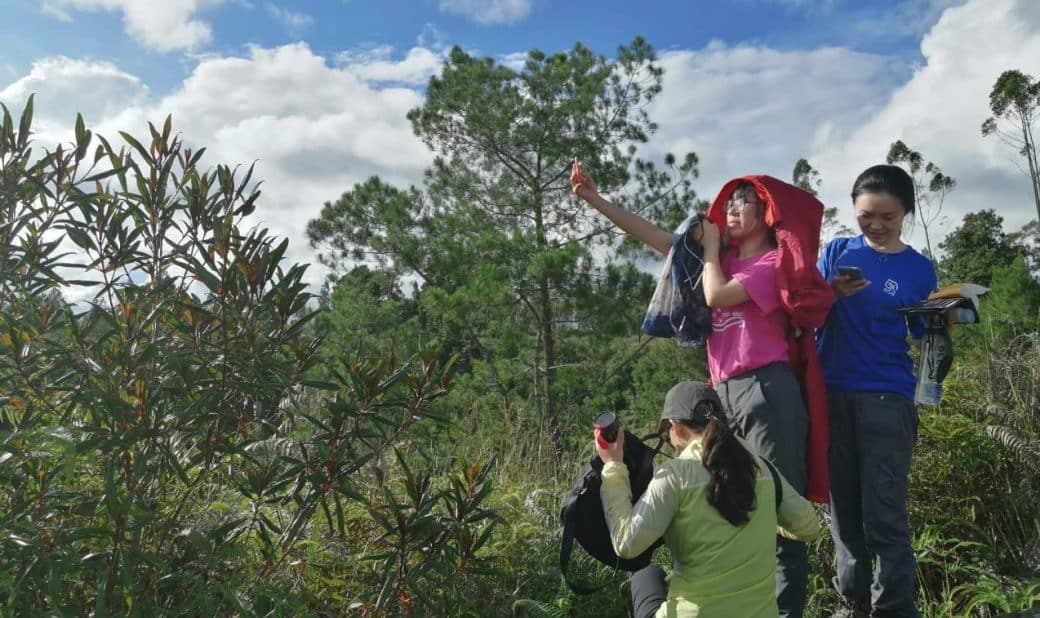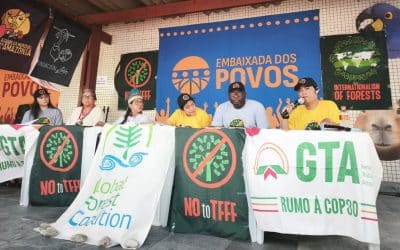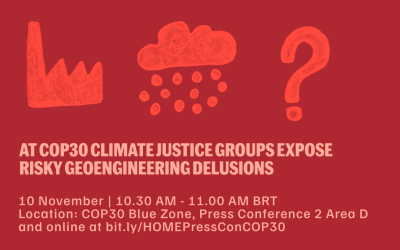Forests are complex living ecosystems—homes, sources of livelihoods, and foundations of life. Yet across the world, they are devastated by extractive industries, agribusiness, and corporate greenwashing disguised as “climate solutions.” Who suffers most? The South, women in all their diversity, gender diverse people, Indigenous Peoples and local communities, including Afrodescendants. Click on the links below to download Forest Cover 69: Exploited Lands, Exploited Lives in PDF, or continue scrolling here to read the full edition online.
Download Forest Cover 69 in PDF
English | Español | Français | Português
In this issue of Forest Cover, our member groups share powerful research and testimonies from Brazil, Bolivia, China, Georgia, Indonesia, Nepal, and Paraguay. Together, we expose the violence of monoculture plantations, mining, and land grabs—and uplift the real solutions led by Indigenous Peoples, women, and local communities.
As we witness another UNFCCC COP, COP30 in Belém, corporate capture of climate negotiations continues to multiply false solutions that commodify nature instead of confronting the systems driving destruction. Forest Cover 69: Exploited Lands, Exploited Lives calls for real, community-led and gender-responsive forest protection and an end to exploitative models that treat forests as commodities rather than living ecosystems.
Forest Cover 69: Six Stories of Community Resilience
In these words there are spirits rooted
in the forms of fish scales, snakes, fruits,
animals,
in fibers narrating the stories of peoples and communities
that venerate the land, the river …
We have never been separated from the earth, from the king vultures,
from the aromas,
not even from the sacred words and the past and
present that come together every day.
Tudruá Dorrico, Ecossistema dos Deuses
By Valentina Figuera Martínez, Global Forest Coalition, Brazil
The world is facing mounting threats, from geopolitical conflicts to climate events and ongoing genocides, while grassroots movements and civil society organizations continue fighting entrenched inequalities. Gender oppressions and colonialism continue to support a violent structure of wealth accumulation that decimates ecosystems and forest communities. There is an overwhelming consensus: time is running out, and systemic transformations are essential to address the root causes of climate change and biodiversity loss.
Forests are crucial for climate regulation, increasing atmospheric vapor, and providing livelihoods for human communities and habitats for terrestrial plant and animal species, but they are under threat everywhere. Meanwhile, global greenhouse gas emissions continue to increase, and corporations and export-driven economies continue destroying biodiversity through polluting activities, environmental deregulation, and perverse incentives like government subsidies. It is clear that global capitalism—with its unlimited economic growth model and false solutions to climate change—has caused so much environmental damage that ecosystems like the Amazon are reaching the point of no return.
In land ecosystems, 3 to 14% of known species will likely face a very high risk of extinction at a global warming level of 1.5°C, unless urgent actions are taken to halt climate change and biodiversity loss. These twin crises are intensified by the influence of transnational corporations, corporate philanthropies, and export-oriented countries over international policy processes. Permanent agriculture, wildfires, and logging are responsible for 87% of tree cover loss since the turn of the century. Corporations and elites are driving the destruction of forests, traditional knowledge, livelihoods, and forest communities, yet they continue dominating international fora and decision-making spaces that claim to seek environmental sustainability. They decide our future and leave the peoples who have historically protected natural commons in a condition of massive dispossession and cruel inequality.
The words of environmental activist and Indigenous leader Berta Cáceres still prevail not as essentialist rhetoric, but as an unequivocal fact: “We must shake our conscience free from the rapacious capitalism, racism and patriarchy that will only assure our own self-destruction.” The rising voices of Indigenous Peoples, local communities, women in all their diversity, gender diverse people, Afro-descendant Peoples, and youth fighting against social inequalities, extractivism, and environmental destruction will continue to echo as long as our rights, territories, livelihoods, traditional knowledge, cosmovisions, and bodies remain under siege. Our words, rooted in ancestral spirits, evidence-based research, and Southern epistemologies, are leaving a legacy of resistance, resilience, political culture, and transformation to protect the world’s remaining forest ecosystems and natural life.
This issue of Forest Cover, with articles by Global Forest Coalition’s member groups in six countries, seeks to politicize the environmental discussion with on-the-ground findings, in a moment of political turmoil where immediate decisions must be made to create territories free of extractivism, fossil fuel exploration, and agribusiness. Here, we highlight the voices of those most affected by industrial monoculture tree plantations, the expansion of agribusiness, and extractive industries. In the places described in the articles from Brazil, Bolivia, China, Georgia, Indonesia, Nepal, and Paraguay, forests are considered sources of commodities to be decimated, plundered, and controlled, similar to women’s bodies under a hierarchical dualism, following notions of the old classic model of colonial extractivism.
The articles here expose a collapsing predatory model by examining industrial monoculture tree plantations and other false solutions to climate change, human rights violations, the expansion of agricultural commodities, and extractivism, highlighting the gender-differentiated impacts of these issues. The objective of the research is to expose the impact of extractive industries and corporate interests on forests, biodiversity, and communities, focusing on how Indigenous Peoples, local communities, women in all their diversity, and youth resist the current threats and pressures through community resilience.
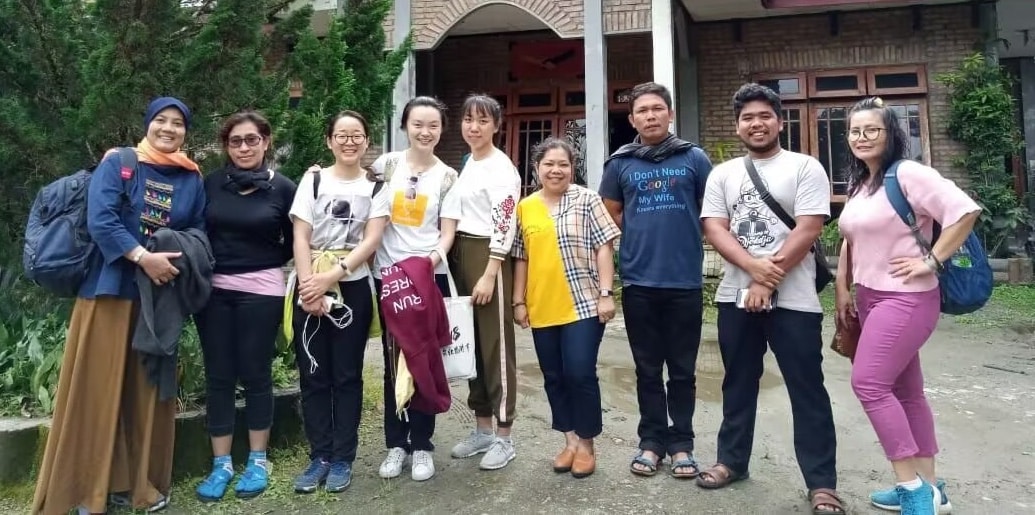
Chinese and Indonesian women leaders at the forefront of defending local communities and forests meet in North Sumatra, Indonesia. EPN
Our Approach to Assessing Gender-Differentiated Impacts
The cases presented here help us understand how extractivism, industrial monoculture tree plantations, and agribusiness (including unsustainable livestock production) affect rightsholders, their livelihoods, and traditional knowledge, and become a barrier to achieving transformative change to save the planet. The articles were developed using methodological criteria to document the gender-differentiated impacts on forests and communities, based on the assertion that the policies that define society’s organization, production, and consumption, and the deforestation, forest degradation and climate change effects caused by the current economic model, are accelerating the decline of all forms of life and are a consequence of colonial legacies in the Global South.
This gender methodology aims to foster Global South epistemologies, challenging Eurocentric knowledge systems and emphasizing the recovery and valorization of knowledge of women in all their diversity, gender diverse people, youth, Indigenous Peoples, and local communities, in facing the direct causes of deforestation, climate change, and human rights violations.
It was developed following gender impact assessment tools and gender analysis guidelines to support integrating gender and intersectionality approaches according to local, regional, and national contexts. Our members used this tool as a basis to create their own gender methodological criteria, map data collection, measure achievements and challenges, and support their commitment to decolonizing knowledges.
Six Cases from Critical Forest Landscapes in the Global South
The first article, by Global Justice Ecology Project (GJEP), exposes the effects of eucalyptus plantations on water, health, food sovereignty, and traditional knowledge systems in a Quilombola community of Volta Miúda, Caravelas, in Bahia, Brazil. Companies like Suzano are responsible for massive ecological devastation in the area, and continue spraying glyphosate and threatening biodiversity.
Additionally, new and irreversible threats from the use of genetically engineered (also called genetically modified or GM) eucalyptus trees are alarming the community and experts. In a historic and devastating decision, Brazil became the first country in the world to approve GM trees for commercial planting after it granted Suzano approval to commercially plant GM eucalyptus trees.
Suzano is planning to expand its industrial plantations in the Brazilian Amazon and the Cerrado, one of the most biodiverse ecosystems on Earth and a critical carbon sink. If the expansion of GM trees continues, it will affect not only the ecological and social balance of Brazilian biomes but also open the door to the spread of this dangerous threat to other countries in the region. In this devastating context, the first article is a global call to demand climate solutions, reject corporate greenwashing, and embrace agroecology, food sovereignty, traditional knowledge, and community-driven forest protection.
The second case, shared by Environmental Paper Network (EPN) China, illuminates the pressing issue of pulpwood plantations and their similarities in China and Indonesia. Chinese investments and rising domestic demand for paper have driven rapid pulp expansion in Indonesia, destroying vast areas of rainforest. Much of the social and environmental impacts caused by this rapid expansion were produced by manufacturing companies Asia Pulp and Paper (APP) and Asia Pacific Resources International Limited (APRIL), which have strong ties to China. The exchanges between women campaigners and activists from China and Indonesia documented in the article deepened understanding of how Chinese investment and consumption are harming Indonesian forests, and strengthened local efforts to fight these threats with community-led solutions.
In Paraguay, the case presented by Centro de Estudios Heñói shows how the district of Bahía Negra, located in the extreme northern stretch of the Paraguayan Chaco, near the border with Bolivia and Brazil, became the main focus of extractive capitalist expansion. Agribusiness represents a threat to local wildlife, ecoregions, and communities, particularly rural and Indigenous women.
The expansion of industrial livestock farming and mechanized agriculture (soybeans, corn, sorghum, cotton, and pastures) has a very high socio-environmental cost. This translates into more deforestation, loss of biodiversity, and displacement of the Chaco’s Indigenous peoples, whose rights to ancestral territories are threatened. In this context, the government continues handing over lands subject to agrarian reform to local land grabbers, while a violent cycle of dispossession, impoverishment, social exclusion, gender injustices, and state violence continues.
The Paraguayan case exposes the reality of the local community, the state of Indigenous and rural women’s rights, and urges immediate actions to ensure socio-environmental public policies and regulatory frameworks to ensure gender equality, respect for human rights, and traditional knowledge, as well as halting the expansion of these destructive activities in the country.
Similarly, the article by Bolivia’s Centro de Investigación y Promoción del Campesinado (CIPCA) exposes a devastating reality, with soy production experiencing a rapid expansion and causing environmental damage since the 1970s. Growing international demand for agrocommodities is motivating the Bolivian government to develop perverse incentives, including a national policy to support unsustainable soy production in the departments of La Paz and Beni, amounting to US$43 million to be implemented between 2025 and 2030.
Furthermore, in 2024 alone, forest fires in Bolivia destroyed 12.6 million hectares of land, 60% of which were forests, smashing records for its worst-ever fire season and scorching an area twice the size of the Netherlands. This unprecedented reality not only left massive ecological devastation and biodiversity loss in an already complicated extractivist context but also put more pressure on Indigenous and rural women who suffer disproportionate consequences.
Legally recognized lands for Indigenous Peoples and local communities in Bolivia are facing an increasing threat: significant areas of territories are being illegally “rented” to third parties, despite their legal status as collective and inalienable property of Indigenous communities. The advance of the agricultural frontier is forcing local communities to sign “agreements” to convert these legally recognized lands to agroindustrial production, which is causing deforestation, gender inequalities, and human rights violations.
From Indigenous and rural women resisting the expansion of agrocommodities in South America to connected struggles against extractive industries in Eastern Europe and South Asia, the cases presented in this issue of Forest Cover expose similar realities in different contexts. The cases expose the need to address structural problems in the current export-driven economic system that is incentivising Global South countries to degrade and destroy ecosystems.
The article by Georgia’s Local Environmental Initiative, describes the turmoil in Chiatura in the central-western area of the country due to unchecked manganese mining, which has devastated land and water, undermined community health, and entrenched gender inequality, leading to unrest.
Despite this reality, the people of Chiatura are increasingly standing up for their rights, and their example shows how a movement that began as discontent among miners has grown into street protests, hunger strikes, and desperate acts, including sewing mouths shut. The article also demonstrates how the people of Chiatura are calling attention to the destructive legacy of manganese mining, which has enriched companies but left residents impoverished, their health compromised, their rights violated, and their homes in ruins.
In Georgia, as in many other countries we read about here, women bear the heaviest burden of environmental decline and social upheaval. Women are mostly unemployed, overburdened with unpaid domestic and care work, and excluded from the labour force because of this unequal reality. Nevertheless, the article exposes an urgent demand: Inclusive, gender-sensitive, and community-driven decision-making to confront corporate interests and the cracks in the earth — and in society.
Governments and corporations frequently promote so-called “responsible mining,” dams, and large-scale infrastructure as development “solutions.” Yet, as the case presented by the National Forum for Advocacy Nepal (NAFAN) on mining companies shows, for communities on the ground, these projects bring dispossession, environmental collapse, and deepened inequality.
In Nepal, the Chepang people, an Indigenous group living in the rugged Mahabharat range, are facing the destruction of their lands by mining companies that advance without Free, Prior, and Informed Consent (FPIC). In particular, it explores the Huaxin Cement Narayani plant on the Dhading–Chitwan border — a Chinese-Nepali joint venture. The consequences have been devastating: human rights violations, gendered burdens, and severe ecological damage. But alongside these harms is a story of community resistance, led in many cases by Chepang women.
The Chepang have not remained silent. They have organized protests, blocked roads, and taken legal action to defend their ancestral lands. In 2024, community leaders halted trucks hauling stone from the Manahari riverbed. And despite police intimidation, the Chepang have won some victories. For example, in Chitwan, protests pushed authorities to suspend operations at the Supar/Starline quarry. In Dhading, residents continue legal battles to hold Shree Kumari Mata accountable. Across the region, women leaders are raising their voices and demanding recognition of land rights, protection of cultural heritage, and genuine participation in decision-making.
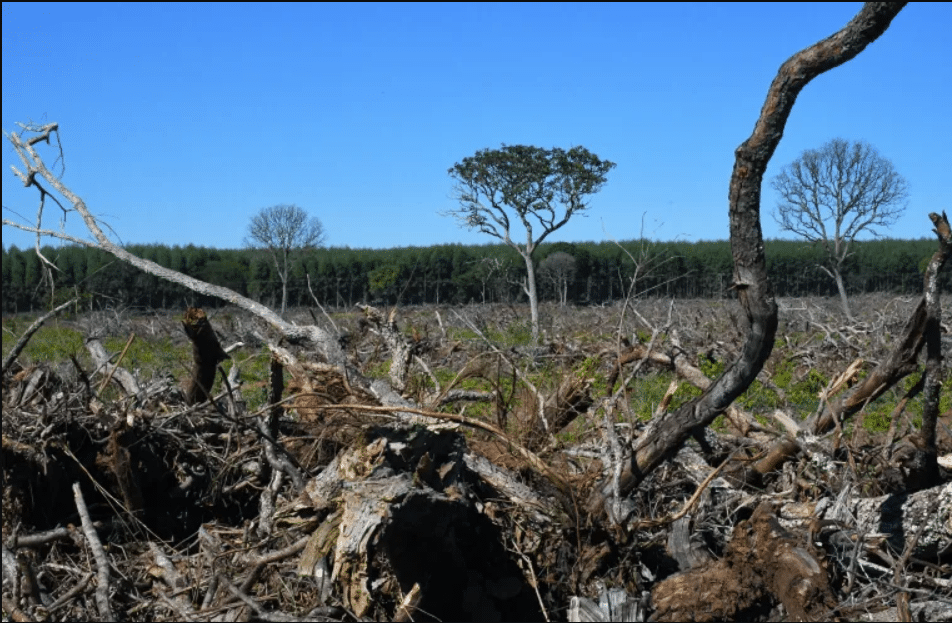
In Mato Grosso do Sul, Brazil, much of the native Cerrado forest has been converted to eucalyptus plantations in the past decade by Suzano. Orin Lanegelle/GJEP
Forest Policy in Focus
Ahead of the 30th UN Climate Conference and the Peoples Summit in Belém, Brazil, the Global Forest Coalition stands firm with grassroots movements’ urgent demands: a halt to extractive activities including big agribusiness and industrial monoculture tree plantations, accountability from corporations and governments, gender and environmental justice, recognition of rights, material reparations and dismantling the infinite economic growth model as essential to climate and biodiversity goals.
Forests are not “green financial products” with a monetary value granted by an invisible hand. Forests are not tradable assets to offset environmental damage, nor raw material suppliers to feed the ideology of “progress” and unending capitalist accumulation. The pressing problem of deforestation is not a “market failure” that can be corrected with mechanisms like the Tropical Forest Forever Facility (TFFF), another false solution to the problem of forest loss and climate chaos.
Forests are complex living ecosystems with intrinsic ecological, cultural, and spiritual value, and they have been protected and co-managed for millennia by Indigenous Peoples, local communities, women in all their diversity, and youth, in accordance with customary laws and traditional cultural practices. In this spirit, we present Forest Cover 69, which we hope contributes to understanding of the existing real solutions to climate change, biodiversity loss, and deforestation.
Big Tech is Driving an Environmental and Socioeconomic Disaster Under the Guise of Climate Responsibility in Brazil
Monoculture tree plantations for carbon offsets are taking over swathes of native forests, destroying ecosystems, displacing communities, and violating human rights, particularly those of Afro-descendant women. This article about Brazil exposes how big tech giants are driving the expansion of these plantations, and calls for such false solutions to the climate crisis to be opposed at COP30 in Belém.
By Heather Lee, Global Justice Ecology Project and Campaign to STOP GE Trees (Canada)
As artificial intelligence (AI), data centers, and digital infrastructures demand massively increasing amounts of energy, big tech giants and corporations are turning to carbon offset markets to maintain a façade of climate responsibility. This includes companies like Microsoft and Apple offsetting their greenhouse gas emissions through purchasing carbon credits from eucalyptus plantations in Brazil.
These industrial tree plantations are expanding rapidly at the hands of corporations like Suzano, the world’s largest pulp and paper producer. Presented as climate solutions, tree plantations commodify nature while also destroying ecosystems, displacing communities, and giving rise to human rights violations.
Meanwhile, calculations of the carbon stored in plantations are questionable. They fail to account for the vast amounts of carbon released from clear-cutting native forests, which are far more carbon-rich and biodiverse, to make room for the plantations. The result is trees planted in perfect rows and columns, optimal for mechanical harvesting and herbicide spraying, with a complete lack of biodiversity—yet the companies purchasing the credits are able to falsely promote themselves as “green” and “carbon neutral.”
Tree plantations are ultimately false solutions to climate change, as they do nothing to stop forest loss, and can even cause natural forests to be razed. They also reinforce a patriarchal and corporate-dominated economic system that oppresses women in all their diversity, Indigenous Peoples, and rural communities.
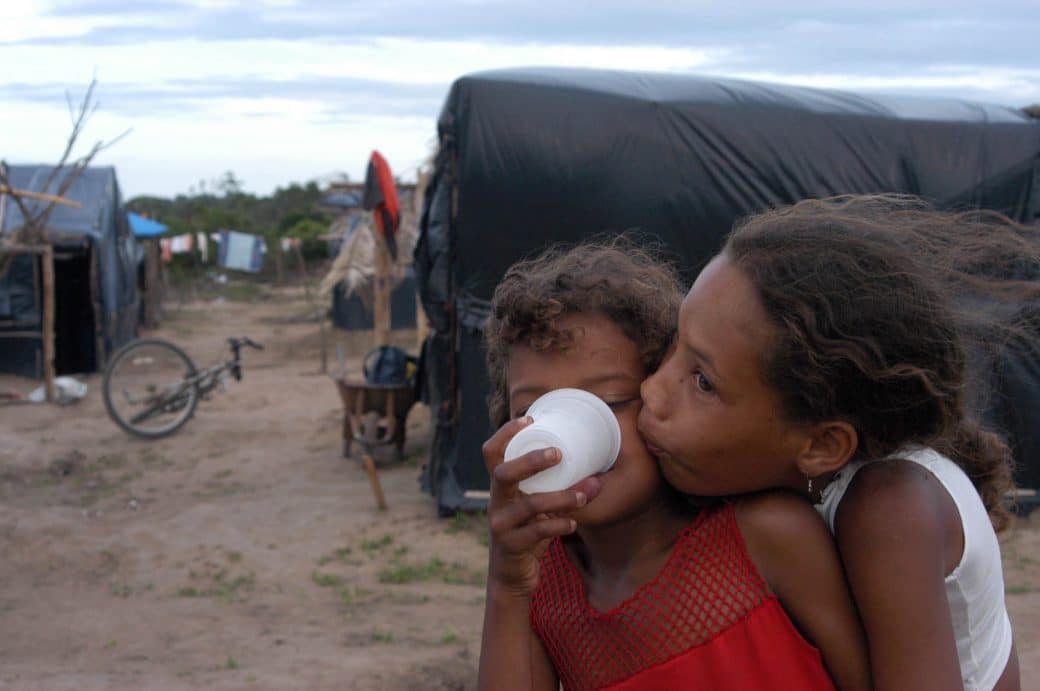
Young sisters in a Landless Workers’ Movement (Movimento dos Trabalhadores Rurais Sem Terra) encampment in Galdino dos Santos in Espirito Santo. Orin Langelle/GJEP
The Gendered and Colonial Impacts of Industrial Tree Plantations
The phenomenon of monoculture tree plantations may be relatively new, but it is a legacy of colonial land grabs rooted in the patriarchal control of resources, and they continue to drive dispossession. In Brazil, the issue is highly political, with the Landless Workers’ Movement (MST, in Portuguese) reclaiming plantation land for settlements of landless peasants. But the massive plantations of companies like Suzano continue to threaten the livelihoods, cultural practices, and health of Quilombola and other forest-dependent communities, including Indigenous Peoples who rely on intact forests and agroecological practices for food sovereignty, cultural identity, and survival.
In 2023, the Campaign to STOP GE Trees, coordinated by the Global Justice Ecology Project (GJEP), led a delegation to Brazil to collaborate with communities and gather testimonies about the effects of eucalyptus plantations on water, health, food systems, and cultural survival.
Celio Leocadio, a leader of a Quilombo community of Volta Miúda, Caravelas, Bahia, stated that the planting of eucalyptus in Espírito Santo and Bahia had grave environmental and socioeconomic impacts. “They removed the native plant cover and all the nutrients from the soil. People here used to do agroforestry, use cover crops, and let the land rest—but now, with eucalyptus, there is no rest for the soil,” he said. “This model of plantations without any kind of environmental requirements by our national and global governments makes it extremely difficult for us as a society, especially for our forest-dependent and Indigenous Peoples.”
Several communities from the Landless Workers Movement we met with were also undertaking important agroecological work, such as training people in the region to grow food organically. The agroecological and agroforestry work of Quilombola communities is significantly impacted by water shortages, the destruction of medicinal plant ecosystems critical to traditional knowledge systems, and the undermining of local food sources. Communities are also exposed to agrochemicals from tree plantations, including glyphosate, which has been linked to various health issues, including increased cancer risk. Women, as caretakers of water, health, and family sustenance, suffer the brunt of these impacts.
Women in the Quilombola town of Angelin II, a matriarchal community surrounded by eucalyptus and sugarcane plantations, testified to us about the impacts of Suzano’s agrochemicals on their environment. They said that they could no longer sell their produce as organic, and many of their livestock were sickened or died due to herbicides sprayed by drones. They also stated that Suzano used surveillance drones to monitor their activities, invading their privacy and homes.

A harvesting machine operating in a eucalyptus plantation. Anne Petermann/GJEP
The New, Irreversible Threats from GM Trees
Brazil’s rural communities now face an even greater threat: genetically engineered (also called genetically modified or GM) eucalyptus trees. In a historic and devastating decision, Brazil became the first country in the world to approve GM trees for commercial planting after it granted Suzano approval to commercially plant GM eucalyptus trees. They are engineered to resist toxic herbicides like glyphosate, kill insects (including pollinators), and grow rapidly. Alarmingly, some of the GM trees combine all three of these traits.
Moisés Savian of Brazil’s Ministry of Agrarian Development has identified corporate interests as the driving force behind the push for GM eucalyptus, saying: “It makes no sense in my view to have a transgenic [eucalyptus] associated with glyphosate. It is much more linked to market interests of the corporations that want to sell herbicides.”
These GM trees will increase agrochemical use, threaten biodiversity, and harm fragile water systems. The problem is only growing; Suzano plans to expand its plantations in the Amazon and the Cerrado, two of the most biodiverse ecosystems on Earth and critical carbon sinks. The pulp and paper producer has named the Amazon region one of the “weedy” regions needing their GM herbicide-resistant trees, which raises serious ecological and social concerns.
During a GJEP press conference at CBD COP 16, Elvis Huni Kui of the Federation of the Huni Kai People of the state of Acre, Brazil, said GM trees “could absolutely destroy the balance of the ecosystem of the Amazon… this is the knife to the throat of our rainforests…the very survival of the Amazon is at stake.”
Suzano is also building the world’s largest pulp and paper mill in a small town in the Brazilian state of Mato Grosso do Sul. The project threatens grave damage to natural habitats, biodiversity, water, and air, and a devastatingly precipitous population influx. The 10,000 workers, most of whom reside in nearby male-dominated worker camps, also increase the threat of violence towards the local population, especially women.
Regional and Global Repercussions
The approval of GM trees in Brazil endangers the country’s forests and people, but also paves the way for widespread commercialization and large-scale release of GM trees across Latin America. Large-scale eucalyptus plantations are already established in Argentina, Colombia, Chile, Paraguay, Uruguay, and Venezuela. GM traits from Brazil could spread to naturalized eucalyptus species throughout the region, threatening cross-border biodiversity and the territorial integrity of Indigenous and local communities.As Gustavo Ulcué Campo of Colombia’s Nasa community and the National Commission of Indigenous Territories (CNTI) explained: “GMO trees threaten Indigenous Peoples’ way of life, ancestral knowledge, and food systems. Defending territories means defending life!”
Violating Rights and Ignoring Indigenous Knowledge
Genetically engineering trees is a dangerous, untested, and irreversible technology. GM trees represent a continuation of colonial thinking—imposing corporate, techno-fixes over Indigenous knowledge and ecological balance. There are also fundamental challenges regarding risk assessments for GM trees due to how risks are framed within different ecological viewpoints.
Tom Goldtooth of the Indigenous Environmental Network sees GM trees as a violation of how we view all life forms and the knowledge of Indigenous Peoples: “This is part of a colonial mentality of a predatory knowledge of property of life. When we talk about our rights, we talk about the forests as well.”
Genetic engineering can also result in unintended and unpredictable changes in trees’ DNA, traits, and behaviour, which may not be noticed in initial tests and could cause serious long-term harm. Geneticist Dr. Ricarda Steinbrecher, an independent scientist with EcoNexus and the Federation of German Scientists, warned in 2023 that “the risks of GM trees are extremely high in terms of the impact on biodiversity, the people living around it, and the global ecosystem and climate.”
GM trees could also be included in false solutions like REDD+ and carbon offset markets, further threatening communities by increasing interest in this risky technology. The company Living Carbon is creating trees that resist decay to “store carbon,” potentially forever, while others manipulate lignin (the tough, woody material that makes trees rigid and slows their decay) for biofuel use, altering the very core of what trees are and transforming their relation to the ecosystem.
“Who has the foolishness [and] ugliness to take the seed from this relative and alter it in whatever manner they do and whatever way those laboratories allow them?” asked Ponca Nation Ambassador on the Environment Casey Camp-Horinek, speaking in 2024. “It hurts how these humans are coming up with these false solutions to what they have created—what they call climate change.”
Brazil Must Be Held Accountable – The Time to Act is Now
Brazil’s approval of GM trees violates the UN Convention on Biological Diversity’s 2008 de facto moratorium on GM trees. No independent, long-term studies exist that prove the safety of GM trees, and geneticists point out that such studies are likely impossible. As Brazil prepares to host COP30 in November 2025, we must not let GM trees become an acceptable climate “solution.”Climate justice must center the rights and demands of women in all their diversity, Indigenous Peoples, and frontline communities. Climate solutions must reject corporate greenwashing and embrace agroecology, food sovereignty, traditional knowledge, and community-driven forest protection.
-
Participants learn how forest concessions have affected Indigenous communities, particularly women, underscoring the need for stronger corporate responsibility. (KSPPM — North Sumatra, Indonesia; December 2019)
From Sumatra to Yunnan: How Cross-Border Exchanges Are Strengthening Women to Lead for Forest Justice
When women from China and Indonesia first met in Sumatra nearly 20 years ago, they discovered their struggles to protect forests were deeply interconnected. What began as an exchange of stories and strategies has grown into a powerful women-led network, uniting grassroots leaders across borders to confront destructive industries, influence investors, and build solidarity for forest justice.
By Wen Bo (China) and Kim Porter (USA), Environmental Paper Network
In 2006, Zhang Huiying, then a program officer at Wuhu Ecology Center in Eastern China, traveled to Sumatra, Indonesia, on a fact-finding mission to investigate the social and environmental impacts of a pulpwood plantation. “The devastation I saw was shocking,” she later reflected. “But the determination of local women to protect their forests showed me our struggles were connected. We needed to act together.”
That mission, organized by the Environmental Paper Network (EPN) and made possible through the leadership of Indonesian partners, marked the first meeting between grassroots women leaders from China and Indonesia. It was the start of an enduring collaboration in which women from the two countries have shared strategies, supported each other’s campaigns, and confronted some of the world’s most powerful pulp and paper companies.
The Roots of Connection
The 2006 Sumatra trip was motivated by urgent threats. Chinese investments and rising domestic demand for paper were driving rapid pulp expansion in Indonesia, destroying vast areas of rainforest. Much of this was led by manufacturing companies Asia Pulp and Paper (APP) and Asia Pacific Resources International Limited (APRIL), which have strong ties to China.
On the ground, Chinese delegates, including Zhang and fellow activist Ding Jie, met Indigenous women whose livelihoods depended on forest resources like incense trees. They learned that corporations’ conversion of diverse forests to monoculture eucalyptus plantations for pulpwood had depleted biodiversity, reduced water availability, and forced women to travel further and further to collect clean water.
These personal encounters helped shift the focus of the Chinese activists’ own work. “It was no longer an abstract supply-chain issue,” said Ding Jie, now a prominent environmentalist and director of the Wuhu Qingye Community Development Center in Anhui province. “It was about real women, real families, and our responsibility to each other.”
“It was no longer an abstract supply-chain issue. It was about real women, real families, and our responsibility to each other.” Ding Jie, director of the Wuhu Qingye Community Development Center, Anhui province.

North Sumatra’s “incense tree” (Styrax benzoin) produces a resin with traditional and modern uses. Beyond its economic value to local communities, it also holds cultural and spiritual significance. EPN
Building a Women-Led Network
Following the Sumatra exchange, EPN began supporting structured opportunities for women campaigners from China and Indonesia to learn from one another. In 2014, Chinese activists returned to Sumatra, while Indonesian women leaders traveled to China for a symposium and learning trip. These exchanges deepened understanding of how Chinese investment and consumption were harming Indonesian forests, and gave Indonesian partners insight into how Chinese NGOs could help raise awareness at home.
Each visit paired community observations with strategy sessions. Women documented illegal logging, pesticide damage on incense trees, and land grabs affecting ethnic minority communities. They also discussed tactics—from media advocacy to investor engagement—to hold companies accountable.
Ding Jie applied these lessons to her own work. She now leads sustainable development projects in rural communities in South China, tackling climate change with practical, locally driven solutions. Reflecting on her journey, she said, “Leadership means having a forward-looking vision, guiding diverse teams toward growth, and embracing inclusivity to advance public welfare and ecological development.”
Linking Struggles Across RegionsThe shared challenges Zhang and Ding observed ran deep. In China’s Yunnan Province, for example, pulpwood plantations, hydroelectric projects, and mining had displaced Indigenous Miao, Zhuang, Wa, Yi, and Dai communities, eroded biodiversity, and destroyed watersheds. Women there faced similar dynamics to those seen in Indonesia: powerful companies, inadequate environmental impact assessments, and disregard for community rights.The exchanges helped participants recognize patterns in corporate behavior and identify opportunities for joint advocacy. In one instance, Chinese activists who had met incense tree harvesters in Sumatra shared their stories in outreach to Chinese financiers, highlighting the gendered impacts of pulp plantations.
Strategy and Solidarity in Yunnan
In 2017, EPN hosted a strategy-building gathering in Xishuangbanna, Yunnan, bringing together 40 activists from 14 countries. Indonesian and Chinese women leaders shared updates on their campaigns and forged alliances with participants across East Asia, laying the groundwork for ongoing collaboration, knowledge exchange, and coordinated action on regional forest and environmental issues.The meeting also planted seeds for local organizing. A women-led Dai cultural preservation society emerged from the gathering, working to protect the local language, traditional practices, and the community’s deep connection with nature. “So much of our culture and traditions have been intertwined with rainforests, peafowl, and elephants,” said Yu Yinghan, who worked as a Dai language news anchor and later founded her own NGO after being inspired by environmental activists she met at the gathering. “I came to understand that defending our culture also means defending our forests.”
Learning in the Field
In 2019, three Chinese women NGO leaders—Mao Jing of Snow Alliance in Qinghai, Liu Rongrong of Wuhu Ecology Center, and Hanna Ye of CDP China—traveled to Sumatra to visit the Nagasaribu Onan Harbangan Indigenous community, which has been affected by the operations of the company Toba Pulp Lestari. Local organizations Lembaga Pemberdayaan Ekonomi Dan Sosial Masyarakat (LPSEM) Riau and Kelompok Studi dan Pengembangan Prakarsa Masyarakat (KSPPM), hosted the delegation, guided by Indonesian conservation leader Woro Supartinah. She showed how eucalyptus plantations had disrupted traditional incense production and increased household labor burdens on women.
The visit allowed women leaders to exchange experiences, witness the impacts of pulp expansion on communities, and strengthen cross-border solidarity in environmental advocacy. The trip was a two-way exchange: Chinese participants saw firsthand the harm done to communities and local resistance efforts, while Indonesian hosts gained new insights into how their struggles could be communicated to investors and decision-makers in China.
Reflecting on her visit, Hanna Ye said: “As villagers shared how Toba Pulp Lestari affected their lives, from leaves that no longer signaled harvest, to seasonal rains as short as half an hour causing landslides. We saw the stark contrast between these realities and the environmental terms the developed world loves: COP, REDD, net zero, traceability, certification schemes. The gap between policy and reality was laid bare. These communities and the forests they protect are the true foundation of any environmental progress.”
New Challenges, Evolving Responses
In recent years, threats to Indonesia’s tropical forests have expanded beyond pulp plantations to include nickel mining and pulp mill proposals from companies like Djarum Group, with supply-chain links to APP and APRIL, often with Chinese financing.
In 2023, Principles for Responsible Investment (PRI) China, an all-women team, and Rainforest Foundation Norway organized a study tour to Oslo for Chinese investors. The trip exposed participants to Nordic environmental, social, and governance (ESG) practices to apply these standards to Chinese overseas investments, including in Indonesia. This initiative reflects the evolution of EPN’s exchanges: starting with grassroots community visits, growing into cross-border collaboration that engages policymakers and investors, and consistently placing women leaders at the heart of environmental advocacy.
Looking Back, Moving Forward
The women-led exchanges between China and Indonesia have demonstrated the power of grassroots diplomacy. They have bridged cultural and political differences, elevated local struggles to international platforms, and nurtured leadership that is strategic and deeply rooted in community realities.Reflecting on the impact, Mao Jing of Snow Alliance said, “These cross-border exchanges help enrich our understanding of deforestation issues that we did not hear much about in the past. We can do a lot in China to help protect Indonesia’s rainforests. We now feel these forests are much closer to us.
”From the first meeting in Sumatra to strategy sessions in Yunnan and investor dialogues in Oslo, these exchanges have been grounded in trust, respect, and shared purpose. They have also faced barriers: funding constraints, political sensitivities, and the challenges of ensuring women’s voices are heard in often male-dominated spaces.Yet, as Zhang Huiying reflected, “Every time we connect, we plant seeds of change, rooted in hope and growing into solutions. The roots are spreading—across forests, across countries, across generations. We hope to continue building this shared strength as we meet, learn, and rise together.
Paraguay’s Chaco Under Attack: The Case of Bahía Negra
By Alhelí González and Sara Montiel, Heñói Centro de Estudios (Paraguay)
The Bahía Negra district, located in the northernmost part of the Paraguayan Chaco, is home to three biomes that contain much of Paraguay’s biodiversity: the Pantanal, the Cerrado, and the dry Chaco. This article highlights the socio-environmental conflicts caused by the expansion of industrial livestock farming and agriculture, a leading cause of deforestation and land concentration in Paraguay, with a special emphasis on the gender impacts and resistance of women and young people from Indigenous and rural communities.
The Chaco, a Living Remnant
The district of Bahía Negra, located in the extreme northern stretch of the Paraguayan Chaco, near the border with Bolivia and Brazil, is a vast expanse of over 3.6 million hectares with a population of under 3,000 people. The most thinly populated region in Paraguay, it includes three important eco-regions: the Pantanal, the Cerrado, and the dry Chaco.
The Pantanal, an ecosystem shared by Paraguay, Brazil, and Bolivia, is the world’s largest wetland. Home to one of the largest concentrations of biodiversity in Latin America, it is known for its great diversity of birds, abundant population of Yacaré caiman, and endangered mammals like the jaguar and marsh deer. This rich biodiversity, however, is under threat. The Chaco region has become the main focus of extractive capitalist expansion in Paraguay, representing a threat to the wildlife, ecoregions, and local populations residing in the territory, particularly rural and Indigenous women.
The Chaco is home to diverse flora and fauna. It is bisected by the Paraguay River, with dry forest zones, wetlands, savannahs, and riverine forests that connect different ecosystems. Historically, the river has been a nexus of human communities, serving as a source of food and income from fishing, as well as a transportation route for native populations that are isolated and lack road infrastructure.
The Yshir and Ayoreo Indigenous Peoples, just like the great branch of the Tupí-Guaraní communities in this region, have traditionally practiced hunting and gathering for subsistence. Their relationship with the land is therefore essentially the opposite of that of Western culture, for they see it not as a source of resources, but rather a source of life, just like the river. The Yshir culture coexists with Western practices in the city of Bahia Negra, albeit with contradictions.
The Chaco region has become the main focus of extractive capitalist expansion in Paraguay, representing a threat to the wildlife,ecoregions, and local populations residing in the territory, particularly rural and Indigenous women.
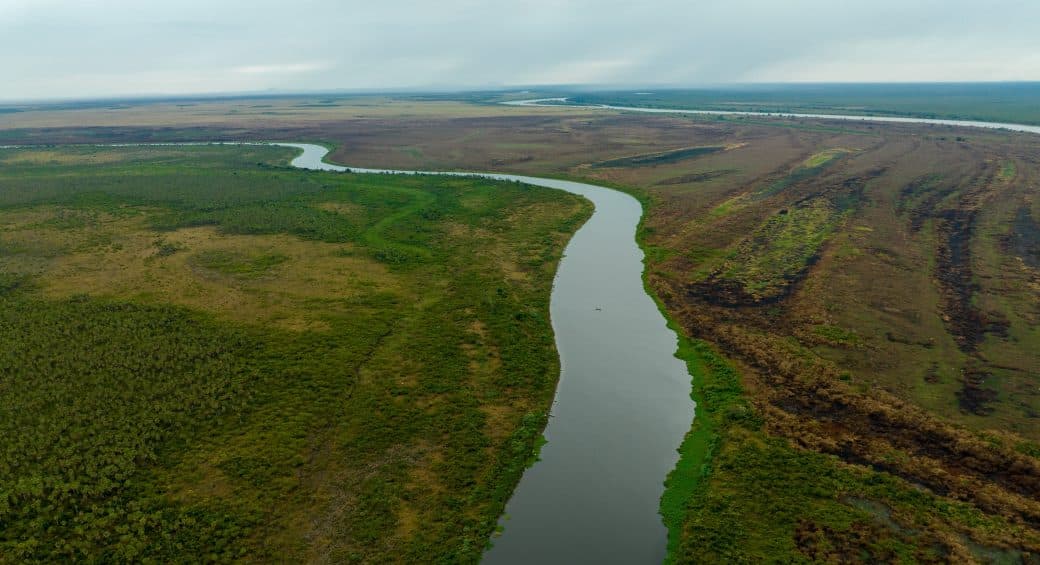
Aerial view of the Paraguay River in the eco region of El Pantanal in the Paraguayan Chaco. Photo: Elisa Marecos and Sandino Flecha.
In Yshir communities, men engage in hunting and fishing or are employed on cattle ranches in semi-feudal conditions, while women perform care work and gathering and make handicrafts to sell using plant fibers. Patriarchal gender relations and the sexual division of labour are firmly rooted in community culture, with men assuming more leadership roles. While questioning the subordinate status and gender oppression of Indigenous women must start from their own local perspectives, we must also problematize these cultural relationships without turning them into a tool of power to discredit Indigenous societies.
Subordination, based mainly on colonialist notions that consider traditional cultures as “savage,” has strong implications for the lives of women and girls and reinforces cultural essentialism. On the other hand, gender injustices at the community level, rooted in traditional discourse, hinder women’s political participation and involvement in community decision-making. In this regard, it is important to highlight the strategies Indigenous women use to challenge traditions, construct their own visions of what it means to be a woman without reproducing hegemonic notions, and open up more equitable spaces for community participation.
Many complexities exist in Bahía Negra, given that it is the center of various extractive processes, such as cattle ranching, mining, and agribusiness infrastructure, and officials are attempting to turn the district into a business logistics hub and a strategic center linked to the Interoceanic Highway that would connect the Atlantic and Pacific and Oceans.
For the population of Bahía Negra living along the Paraguay River, one of the main waterways in the region, daily life centers around the water and the now scarce forestland. The river represents life for native communities like the Yshir Ybytoso, which have lived on this land since the formation of the Paraguayan nation-state. Near the Yshir are the Ayoreo community, the only Indigenous community in voluntary isolation in this region. Their lives and culture are under threat due to the steady advance of the agricultural frontier for agribusiness.
The Extractivist Offensive
Since the agricultural commodities “boom” of the early 2000s, the Chaco has undergone deep social and territorial transformations. Paraguay’s economy, which is primarily export-based, relies heavily on cattle ranching, and this sector accounts for a large share of national production.
Paraguay is the world’s tenth-largest beef exporter, having sent 470,000 tons to markets abroad in 2024. According to data from the Mesa Paraguaya de Carne Sostenible (MPCS), 2.12 million head of cattle are slaughtered each year, representing about $1.35 billion, making this sector one of the biggest sources of foreign exchange.
Industrial meat production is mainly geared toward export, which explains the sustained increase in beef prices in the domestic market, and its substitution by other sectors, such as poultry and pork, which have seen unprecedented growth in the last decade. The country’s livestock sector includes 291,497 farms and over 13 million head of cattle, which accounts for its considerable influence in the development of agricultural policies, including the institutional framework around agribusiness.
Cattle ranching is one of the main causes of deforestation and the concentration of land ownership in Paraguay. In the district of Bahía Negra alone, there are more than 100 large farms with a herd of around 1.8 million, mostly owned by Brazilian businesspeople.
According to data from the National Agricultural Census, Paraguay has 617 farms larger than 10,000 hectares each (more than about 25,000 acres). Of these, 536 account for over 3.5 million head of cattle. In contrast, 25,300 farms are less than one hectare each in size, with 58,410 head of cattle distributed among 10,026 farms engaged in small-scale livestock production. Overall, livestock farming accounts for around 19 million hectares nationally (CAN, 2022).

Yshir youth are transported to work at cattle ranches. Elisa Marecos and Sandino Flecha
The expansion of livestock farming and mechanized agriculture to produce soybeans, corn, sorghum, cotton, and animal feed has very high socio-environmental costs. It causes deforestation, loss of biodiversity, and displacement of Indigenous Peoples in the Chaco whose rights to ancestral territories are threatened, which often goes hand in hand with impoverishment, social exclusion, and state violence. In particular, Indigenous women are exposed to violence against their bodies, specifically in the case of girls and adolescents who are victims of sexual exploitation.
A recent study on the situation of Indigenous children in Paraguay points out that extreme poverty and lack of adequate infrastructure hinders the full exercise of other rights such as access to education and health. This leads to Indigenous children and adolescents being forced by economic conditions to leave their communities and migrate to cities, where they are exposed to extremely precarious conditions that reproduce the cycle of poverty and marginalisation of the Indigenous population.
Access to land is the main social conflict arising from the agrarian capitalist model, and indigenous and peasant women suffer disproportionate impacts, as their rights to communal or individual land tenure is not widely recognised in the country. Nor are there robust public policies aimed at guaranteeing gender equality in land tenure, despite the fact that Paraguay is a signatory to the Convention on the Elimination of All Forms of Discrimination against Women, which establishes equal participation and benefits for women in the rural context and in agrarian reform.
Public institutions have played a leading role in legitimising the agro-export model. Of particular note is the position of the National Institute for Rural and Land Development (INDERT), which, using legal devices, maintains a tacit policy of handing over land subject to agrarian reform to large local and foreign capital linked to agribusiness. These fraudulently obtained titles exacerbate land conflicts between large landowners and rural, peasant and Indigenous communities who are resisting in order to preserve their territories and ancestral cultural practices.
New markets for Paraguayan meat have exacerbated socio-environmental problems in these territories. Practices such as ‘controlled burning’, which are used to prepare the soil for changes in productive activity, have caused huge forest fires that in 2024 destroyed approximately 230,000 hectares in the western region of the country. Some 150,000 hectares of burned earth were located in the Cerro Chovoreca National Park area. According to data from the National Forestry Institute (INFONA), in early 2025, INFONA extended the total suspension period for the authorisation of burning permits to prevent forest fires. These types of practices mainly affect native forests and areas of high ecological value. A visit to the district and territories confirmed that nature reserves and parks are surrounded by livestock farming in the Chaco, while large areas of forest have been appropriated by foreign landowners.
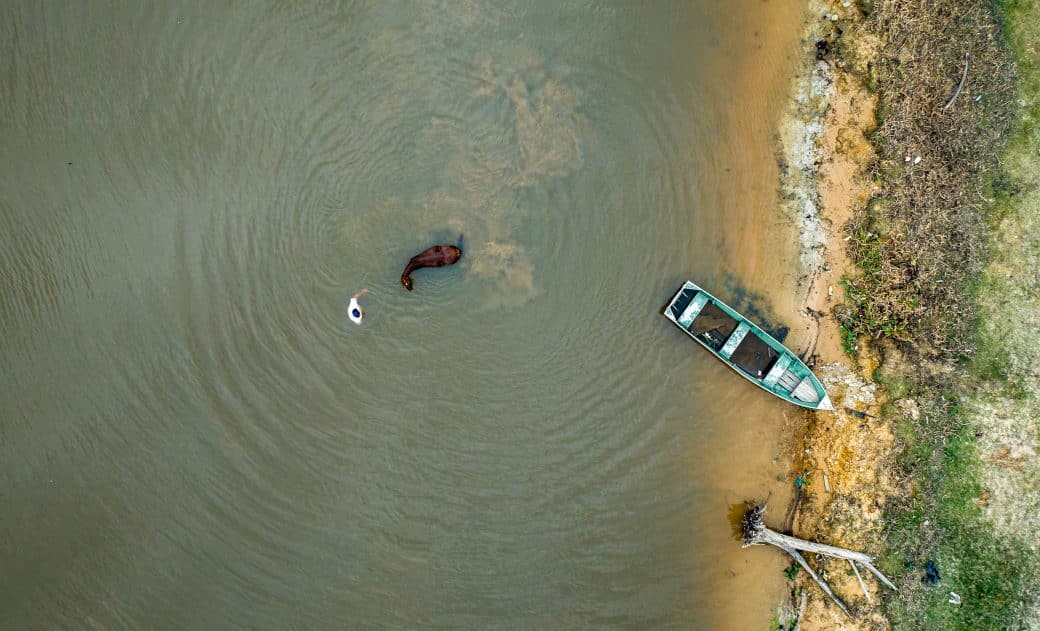
A fisherman bathing his horse in the Paraguay River. Elisa Marecos and Sandino Flecha
The Socioeconomic and Environmental Impacts of Soy Expansion in Bolivia’s Lowlands for Indigenous Communities
By Mario Vargas and Cecilia Peñaranda, Centro de Investigación y Promoción del Campesinado (CIPCA-Bolivia)
In Bolivia, soybeans have become the main agricultural export product. This article presents critical reflections on the expansion of soy cultivation in the Bolivian lowlands, which is being promoted by the government and has led to worsening wildfires and loss of territory for Indigenous groups. It also describes Indigenous women’s leadership in defending forests against the expansion of the agricultural frontier.
Bolivia is one of the world’s megadiverse countries, with three broad regions: the highland altiplano, the dry Chaco, and tropical Amazonia. Some 39% of the population self-identifies as Indigenous, and 23% of the country comprises Native Indigenous Peasant Territories (in Spanish, Territorios Indígenas Originarios Campesinos, or TIOC). These areas are legally recognized communal properties by which the federal government grants land rights to Indigenous and peasant communities. However, despite progress on rights, Indigenous Peoples face displacement and aggression from mining activities, timber extraction, cattle ranching, and the advance of the agricultural frontier for agribusiness.
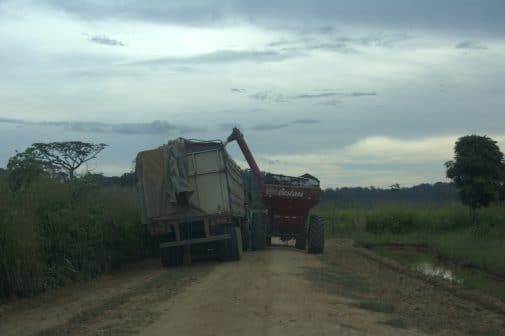
In the municipality of San Andrés, Beni department, oilseed production is fully mechanized, from planting to harvesting. Mario Vargas
Public policies, new export markets, and access to new technologies, particularly since the 1980s, have transformed agricultural production in Bolivia. The amount of land dedicated to cultivation increased fivefold between 1983 and 2023, reaching 4.57 million hectares.
The growth in agricultural production has been concentrated in the eastern plains and the Amazon basin, particularly in the eastern lowland Department of Santa Cruz, which in 2023, accounted for over 70% of crops, primarily wheat, sorghum, maize, and soybeans. For soybeans alone, this department is responsible for 97% of national production, followed by neighboring Tarija and Beni.
Policy Support for the Expansion of Soybean Cultivation
Soybeans first began to be grown in Bolivia in the 1970s. Because of rising international demand and public policies favoring the industry, a soybean boom occurred in the 1980s and 1990s, with the first genetically modified seeds introduced in the early 2000s.
A watershed moment was the beginning of the World Bank’s Eastern Lowlands Project in 1990, which sparked an era of new subsidies for soybean cultivation expansion. This project was the first to promote mass-scale cultivation of soybeans in Bolivia, and it laid the foundation for more expansion by establishing the institutional and financial infrastructure that to this day sustains agribusiness here: specialized credit systems, consolidation of business networks that coordinate production, processing, and exportation, as well as mechanisms for subsidies and tax exemption for soybean production and export abroad.
By 2020, Bolivia had become a leading exporter of soybeans alongside Brazil, with 85% destined for export, mainly to China and the United States, illustrating the strong regional impacts of global markets. Estimates suggest global demand for soybeans could double by 2050, driven by markets for soybean cake or flour, a subproduct used for animal feed.
Bolivian public policy promotes an extractivist model of production through which the state provides steady support for agribusiness. A clear example of this support is Supreme Decree 5381 of 2025, through which the Bolivian Government created a national program to strengthen soybean production in the Departments of La Paz and Beni as new poles of agroindustrial development. The program has an investment of US $43 million for 2025–2030, intending to reach 200 million tons of soybeans planted over 61,000 hectares.
Soya is one of the most heavily state-supported crops in Bolivia, promoted for its use in animal feed and biodiesel. A biodiesel plant with a max capacity of 1,500 barrels per day was built in the city of Santa Cruz in 2024, billed as an “environmentally friendly” way to ensure energy security. The Department of Beni is also pursuing the expansion of the agricultural frontier as part of its latest Land Use Plan.
Loss of Forests, Biodiversity, and Livelihoods
The soybean boom is not the only thing transforming the landscape of Bolivia’s eastern lowlands. In 2024, Bolivia saw a record number of wildfires, with some 12.6 million hectares burned, an area the size of Portugal. Of that amount, 60% was forest land, and the remaining 40% was non-forested and pastureland. The most affected areas by far were Santa Cruz (68% of the national total) and Beni (28%).
Wildfires in Bolivia happen on four different types of land, which we can differentiate according to their legal status. The first group is individual properties or communities settled illegally in areas unauthorized for occupation or agricultural use. The second is illegal settlements and parcels within the Native Indigenous Peasant Territories (henceforth TIOC). There are also newly denominated intercultural communities, which include migrants from different parts of the country who have settled on state-owned land, with or without authorization to do so. The fourth group consists of legally established medium and large properties owned by agricultural and cattle ranching businesses.
Frequent wildfires are not just an environmental threat; they also spark social injustices that hit women hardest. As guardians of traditional knowledge and caretakers of the land, women suffer the direct consequences of environmental degradation. Several women-led productive initiatives to promote the sustainable use of forest products have been affected by fires, and some have lost everything, both the source of their primary inputs and their infrastructure, limiting their ability to generate income and achieve financial autonomy.
After wildfires, it is often difficult to rebuild homes and restore family dynamics in the communities. Men typically leave to find temporary work in urban centers or on cattle ranches to earn money to rebuild their homes and replant their citrus, cacao, and cassava crops, among other important food and income-generating crops. Meanwhile, women play crucial roles in the rebuilding processes at home: they clean up the aftermath of the fires, prepare the soil for replanting their crops, and take care of their children, the elderly, and the sick. They may also engage in the public sphere. In terms of the gender division of labor, women bear the brunt of caregiving tasks, while men generally do not assume active roles in domestic care work.
Pressures on Indigenous and Peasant Communities
Illegal settlements and land ownership are a perennial problem within Native Indigenous Peasant Territories (Territorios Indígena Originario Campesinos -TIOCs). It is increasingly common to see significant areas of land under the control of “third parties,” despite the status of these territories as collective and inalienable property of Indigenous Peoples. The advance of the agricultural frontier generates instances of illegal land use agreements with leaders and communities in TIOCs, which involve deforestation and the implementation of agro-industrial crops by “third parties,” who pay to “rent” the land averaging US$220 per hectare per year.
The system of deforestation to develop agricultural land destroys the entire forest, prevents the creation of natural buffers with forest between each plot, and promotes intensive land use with no replenishment of nutrients and organic matter to the soil. This means that in the medium and long term, the land becomes depleted and degraded. The territory becomes a kind of vicious cycle of deforestation to clear new agricultural land. Ultimately, this is an unsustainable agricultural model that undermines food production.
For Indigenous communities, forests are of great importance from a cultural, spiritual, economic, and environmental perspective. They are sources of sustenance and livelihood, providing food, medicinal plants, and materials for housing and daily activities in the community. According to the worldviews of the Indigenous Peoples who have lived in these territories since ancient times, the forest is sacred, the home of ancestral spirits, and a place for traditional rituals and ceremonies. Because of the extractive agribusiness model so readily adopted in Bolivia’s eastern lowlands, forests are increasingly destroyed and degraded and Indigenous groups suffer violations of their constitutional rights.
Three broad trends are reconfiguring the lives and territories of Indigenous and peasant communities in Bolivia. First, climate change has altered water resources, affecting the biological dynamics of the forest, with a reduction or total loss of forest products that are important for humans and wildlife. Second, lack of water is affecting fishing and the cultivation of traditional crops for food security and sovereignty. Third, there is a lack of efficient and gender-sensitive public policies for the communities, many of which are located in Indigenous territories where there are no integral services provided by the state, which instead facilitates illegal activities such as mining. Finally, pressure from the agricultural frontier is forcing Indigenous and peasant communities to enter into an illegal system of land use agreements with “third parties.”
These factors increase dependence on agribusiness income, whether through the “rental” or sale of Indigenous Peoples’ land or their employment as laborers in agribusiness activities. Indigenous and peasant communities are less likely to grow their own food and engage in traditional hunting and gathering practices in the forest, which can affect family farming, leading communities to depend mainly on purchasing food in urban centers, increasing the cost of living. This form of income generation disrupts their way of life, accelerates the loss of ancestral wisdom, encourages a detachment from their worldview of the forest, and promotes the expansion of the agricultural monocultures for export.
Indigenous women play central roles in defending forests, and they are also closely tied to environmental protection and conservation of non-forest non-timber forest products, promoting traditional medicine, and providing household income. For example, the Chiquitana Indigenous Women’s Organization (Omioch-C) and the association of women entrepreneurs of the Municipality of Concepción helped create a public policy on the conservation, gathering, processing, and sale of non-timber forest products. They presented the Law on Non-Timber Forest Products to the city. The Omioch-C also developed a brand called Chapie, allowing them to sell products like almonds, coffee, honey, yucca in local, regional, and national markets.
Women Leaders Take on Environmental Degradation
The advance of the agricultural frontier for soybean production has led to deep environmental and socioeconomic transformations in Bolivia’s lowlands, with profound impacts on peasant and Indigenous communities. Increased deforestation, soil degradation, and wildfires are the result of a production model that enjoys strong state support and international financing.
These impacts are perpetuating social inequalities and gender injustices, threatening food security and sovereignty, and also undermining cultural reproduction for Indigenous People and local communities. The reproduction of life is threatened for communities facing precarious situations, such as environmental degradation and reliance on renting communal land to third parties for income.
The territorial pressure generated by extractive industries like agribusiness, mining, and logging has incentivised mechanisms for land grabbing and trafficking. The TIOCs are exposed to these ills and become even more vulnerable over time, whether due to encroachment on their lands or the effects of climate change. Abandoned by the state, communities are faced with loss of food sovereignty, gender injustices and the rising cost of living, which puts their very existence at risk.
In addition to their leadership in the realm of production and environmental protection, Indigenous women in Santa Cruz are investing their time in training, obtaining certifications as community advocates against domestic violence, which helps establish them as key actors in promoting equity at home. Indigenous women are also fighting for the recognition of their rights and territories to guarantee their livelihoods, halt the expansion of agribusiness, and combat wildfires.
In all these processes, women have long been present, but too often invisible. Women’s leadership and resistance deserves greater recognition because of their key contributions to agroecology and forging real solutions to pressing twenty-first-century problems like food insecurity, the climate crisis, and destructive capitalist and consumerist practices.
The expansion of soybean cultivation in Bolivia’s lowlands has deepened an extractivist model that prioritizes agribusiness over the rights and well-being of Indigenous and peasant communities. Its impacts—deforestation, wildfires, and loss of biodiversity—threaten local livelihoods and cultural continuity. Yet Indigenous women have shown remarkable leadership in defending forests and promoting sustainable, community-based production. Recognizing and supporting these initiatives is essential for a more just and sustainable future for Bolivia’s lowlands.
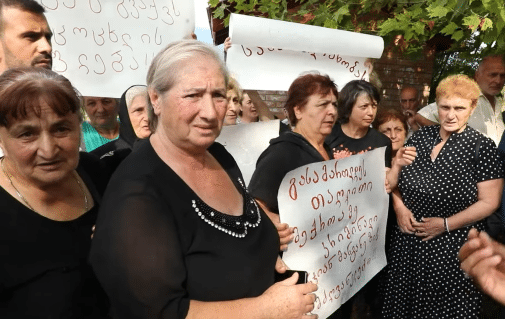
Protest in Rgani village, sign reads “Some houses that used to stand on the meadow now stand on the edge of a cliff several meters deep”. Local Environmental Initiative
Cracks in the Earth: The Human and Environmental Cost of Manganese Mining in Georgia
By Nino Beridze, Local Environmental Initiative, Georgia
This article examines the environmental and socioeconomic harm caused by decades of unregulated manganese extraction in Chiatura, Georgia. It describes the environmental damage, highlights how women and youth are especially vulnerable, and outlines the need for urgent reforms.
The mining town of Chiatura in central-western Georgia has been in turmoil for years. Unchecked mining has devastated land and water, undermined health, and entrenched gender inequality, leading to unrest. The people of the area are increasingly standing up for their rights. What began as discontent among miners has grown into a movement involving street protests, hunger strikes, and desperate acts, including sewing mouths shut. Residents are calling attention to the destructive legacy of manganese mining, which has enriched companies but left residents impoverished, their health compromised, their rights violated, and their homes in ruins.
Manganese mining in Chiatura began in 1846 in the Kura and Rioni River basins. For over 150 years, environmental protection has been neglected, and mining waste has reshaped the landscape. A study by the Chiatura Residents’ Union describes “radical changes” in the topography, with soil and vegetation destroyed, sinkholes and funnel-shaped deformations, and large-scale landslides causing erosion and desertification.
Villages like Darkveti, Mgvimevi, Khalifauri, Rgani, and Tabagrebi have lost hundreds of hectares of forest and dozens of hectares of soil to open-pit mining. Even 30 kilometres from the mines, air pollution remains hazardous. Abandoned and active mines dot the countryside, with a maze of around 200 kilometers of tunnels underground. Winds and rain spread heavy metal dust across the region, contaminating water, soils, and crops, and endangering humans and animals.
According to reports, none of the manganese plants have operational wastewater treatment. Rivers like the Kvirila turn black with manganese leachate. In some stretches of the river, the manganese content in water is many times higher than the safe limit, with the Chiatura Residents’ Union reporting levels of 600 milligrams per litre, more than 50,000 times the “normal” level. Concentrations of other heavy metals, such as lead, nickel, cobalt, and zinc, are also far above permissible levels. In 2009, at the entrance of Chiatura, the recorded concentration of manganese ions in the Kvirila River was 3.9 milligrams per litre—over 40 times the permissible levels.
According to the 2020 study, soil samples from several investigations show arsenic and lead at several times the legal limits, and manganese well above the maximum allowable concentration in places like Ithvi. Cadmium, arsenic, cobalt, copper, zinc, manganese, iron, nickel, aluminium, and radioactive isotopes of potassium and lead were found in soil samples, with concentration levels several tens of times over legal limits. Hazardous metals in these high concentration levels in the water and soil contaminate agricultural products and pose health risks for humans, animals, and the environment.
In the village of Ithvi, the concentration of manganese in the soil is 140,000 mg/kg—93 times higher than the maximum allowable concentration. Elevated levels of other heavy metals, such as cadmium, copper, zinc, and nickel, were also recorded. The copper content in the soil is 1,070 mg/kg, seven times higher than normal, while manganese levels are 180 times higher than acceptable standards. These toxins are absorbed by crops, making local food potentially unsafe for consumption.
Despite the visible destruction, no comprehensive statistics exist on the full scale of environmental damage. Loose legal norms and weak enforcement mean mining companies often operate unchecked.

A landslide that destroyed houses in Ithvi village. Local Environmental Initiative
The Cost of What Lies Beneath
No areas of Chiatura are protected from the reach of mining companies. Extraction appears to be occurring everywhere: in pastures, along roads, beside homes, and even under villages. Houses that once stood on solid ground now teeter on the brink of collapse as tunnels erode the earth beneath them. In Ithvi, years of mining led to an 800-meter-long landslide that destroyed or rendered 20 homes uninhabitable and put dozens of families at risk. The state commission investigating the disaster blamed historic mining, deflecting responsibility from the current operator.
In Chiatura, mining zones and residential areas are indistinguishable. Schools and daycare centres lie within extraction zones, and children often walk to school through quarries. Ambulances struggle to reach homes due to destroyed roads. In Mgvimevi, abandoned mining hills are a short walk from residents’ doors, and the ever-present dust and stench are reminders of the ongoing crisis.
Rgani, once home to chestnut forests protected under Georgian law, has lost its pastures and trees to mining. “Near my house, there wasa whole field covered with chestnuts… I have never been a complaining person, but I am very angry… In summer, you can’t open a window or hang clothes outside. Everything is covered in dust, people get sick,” said one female resident, who asked to remain anonymous due to fear of reprisals.
Experts from Tbilisi State University say fertile land has become barren, water sources have disappeared, and the natural balance is shattered. Anthropogenic impacts have replaced forest ecosystems with degraded shrubland, especially in karst and plateau areas where water is scarce. Overgrazing—driven by economic desperation—has further slowed vegetation recovery.
Manganese pollution stems mainly from mining and industrial processes. According to the World Health Organisation, chronic exposure to manganese and other heavy metals harms haematological, kidney, and liver function, with the central nervous system especially vulnerable. Women are particularly at risk. Elevated manganese in blood is linked to increased infertility, complications during pregnancy and childbirth, and chronic fetal hypoxia. These gendered health impacts often go unrecognised and untreated.
Not a Woman’s Problem?
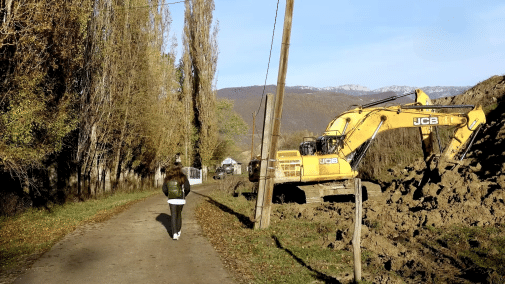
Mining equipment works along a residential road in the Chiatura region. Local Environmental Initiative
Mining appears to be a male domain, as most workers are men, but women are often the driving force behind community protests. Why is this the case? In Chiatura, women bear the brunt of environmental decline and social upheaval. Women are mostly unemployed, overburdened with unpaid domestic and care work, and excluded from the labour force because of this unequal reality. According to the International Labour Organization, most Georgian women remain outside the workforce because of their care responsibilities. Furthermore, surveys of the Georgian populace show that gender inequality is more pronounced in rural and mono-industrial regions like Chiatura than in cities.
Traditional gender norms, though not enshrined in law, mean that men typically inherit property, while women are rarely registered as owners, and the gender pay gap in Georgia stands at 33% on average. In mining regions, women lack land and assets, making them more vulnerable to displacement and poverty.
Although there are legal provisions for gender equality in Georgia, recent policy reversals, such as the removal of quotas for women MPs, signal backsliding. The government increasingly dismisses gender equality and condemns certain sectors of the population as influenced by foreign imposition and meddling by overseas NGOs, claiming they pose a threat to “traditional” values. This further marginalizes women’s rights.
This is nothing but a false premise. After all, gender justice is not an antithesis to traditional knowledge. Ensuring women’s rights is a fundamental human right—not a matter of charity or the concern of NGOs alone. Gender justice fosters peace and societal harmony by eliminating the root causes of conflict, inequalities and discrimination. Research shows that involving women in economic and social life boosts productivity and prosperity. In fact, “investing in women and girls”—expanding their economic rights and opportunities—is a key driver of broad-based development and economic growth.
One example of gender inequality rooted in tradition, rather than law, concerns women’s property rights. Although Georgian law does not assign property rights based on gender, an implicit norm grants men priority. Parents usually leave property to male heirs. Consequently, women register property far less frequently than men in almost every region of Georgia, particularly outside the capital. This pattern is evident in mining regions: most women do not own strategic assets—they live in their father’s or husband’s house and are not regarded as the owners. Thus, the dire situation in mining regions exacerbates existing gender inequalities.
An Imbalance of Power
Manganese extraction in western Georgia is dominated by a handful of companies, with the largest actor by far being Georgian Manganese, a subsidiary of British steel company Stemcor, with an unofficial turnover of millions, but the company has refused to publish its financial documents. Yet Chiatura remains among the poorest areas of Georgia, with 23% of residents classified as socially vulnerable and reliant on state benefits.
Mining operations are mostly subcontracted, making accountability opaque and allowing companies to skirt regulations. Worker and community protests are frequently ignored. This legal murkiness enables the industry to put corporate interests above public, social, and environmental concerns.
Licenses allow Georgian Manganese to mine until 2047, even as easily accessible reserves dwindle. Rather than invest in new technologies or diversify, companies are pushing into new territories, such as the mountain village of Shkmeri. Residents there only learned of plans to mine after licenses were quietly sold and their plots seized by the prosecutor’s office. The site includes a protected cultural heritage monument, St. George’s Church, but objections from the National Agency for the Protection of Cultural Heritage were ignored. Locals had hoped to build a future on agriculture and tourism.
Mining companies often simulate public support through staged consultations or informal deals with select families, while denying any responsibility for past damage. Local authorities claim there are no alternatives to mining, citing Chiatura’s monocultural economy and poor soils as barriers to agriculture.
Digging Out of the Crisis
Chiatura’s history is interwoven with manganese mining. The extractive industry, shaped by Soviet-era practices, has disrupted ecosystems, destroyed property, and buried the region’s future. It is a stark example of how unchecked resource extraction can devastate communities, especially when gender and environmental concerns are ignored.
Local advocates insist the true costs of mining—environmental, health, and social—must be fully studied and accounted for. New permits should require rigorous social, economic, and environmental assessments, with genuine input from affected communities, especially women and youth.
Mining companies must be compelled to remediate past damage, restore soils and forests, and contribute to community well-being, including through investing in alternative livelihood opportunities—such as hazelnut cultivation or eco-tourism. Otherwise, Chiatura faces further depopulation, deepening poverty, and irreversible ecological loss. Only by ensuring real representation and participation of women and young people in governance—and by fully implementing Georgia’s Association Agreement with the European Union, which mandates comprehensive, participatory decision-making—can the balance between extractive industries and local communities be restored.
Inclusive, gender-sensitive, and community-driven decision-making is essential. Without it, the gap between corporate interests and local well-being will continue to widen, and the cracks in the earth—and in society—will only deepen.


